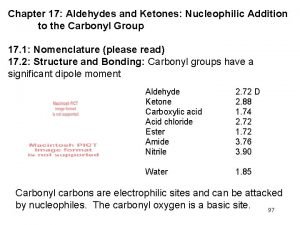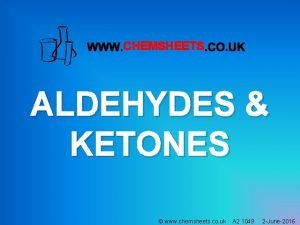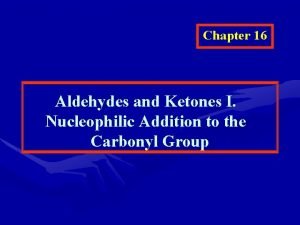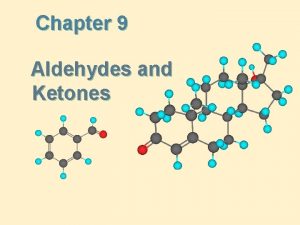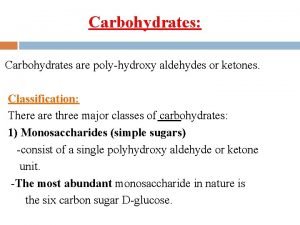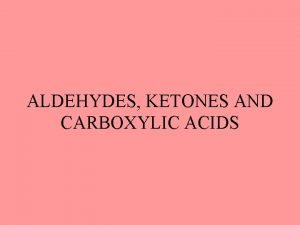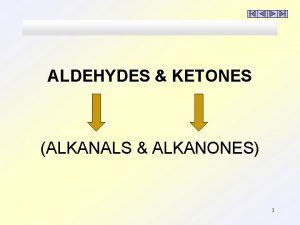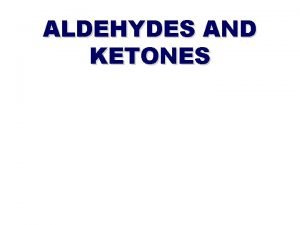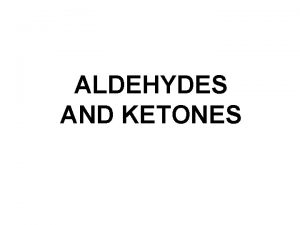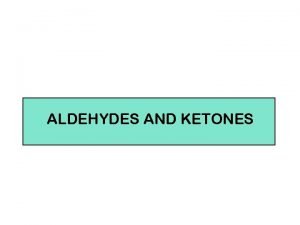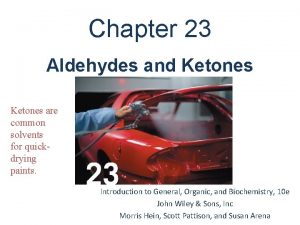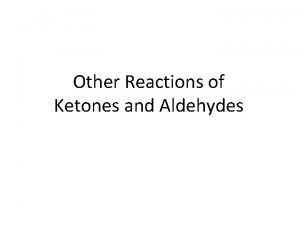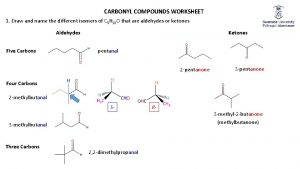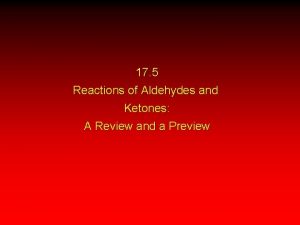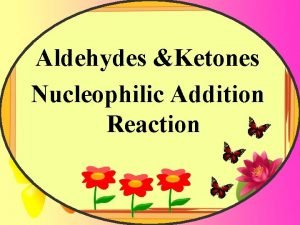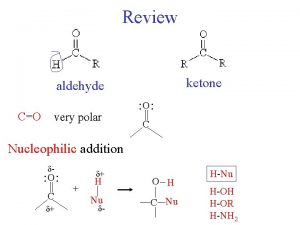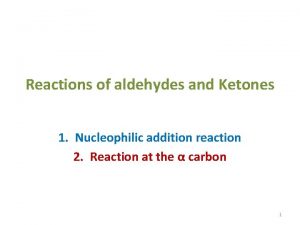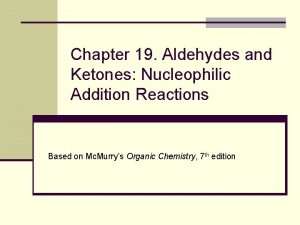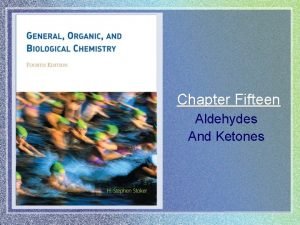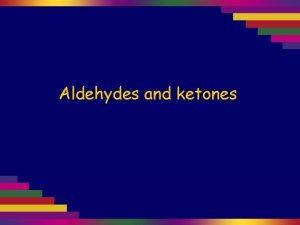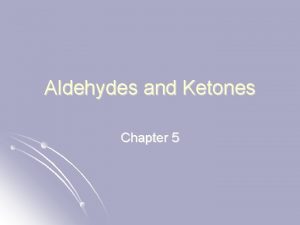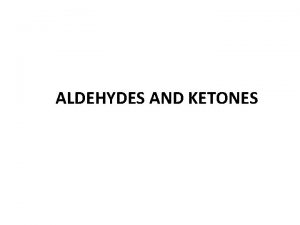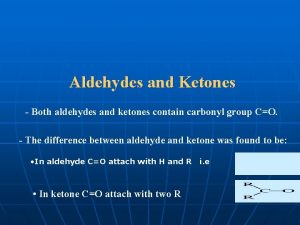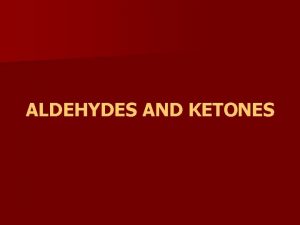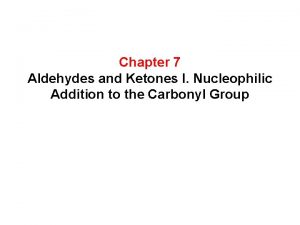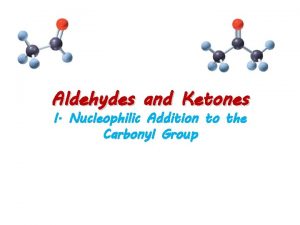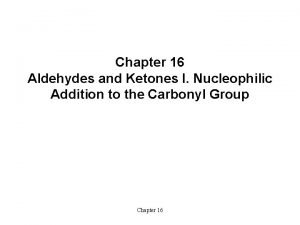Reactions of aldehydes and Ketones 1 Nucleophilic addition

















- Slides: 17

Reactions of aldehydes and Ketones 1. Nucleophilic addition reaction 2. Reaction at the α carbon 1

Aldehydes & ketones, reactions: 1. Oxidation 2. Reduction 3. Nucleophilic addition reaction a) Addition of cyanide b) Addition of derivatives of ammonia c) Addition of alcohols d) Cannizzaro reaction e) Addition of Grignard reagents 4. Reaction at the α carbon a) Alpha-halogenation of ketones b) Addition of carbanions 2

1) § Oxidation Aldehydes are readily oxidized to yield carboxylic acids; but ketones are generally inert toward oxidation. Many oxidizing agents, including KMn. O 4, Cr. O 3 in aqueous acid and hot HNO 3, convert aldehydes into carboxylic acids. § Oxidation of an aldehyde can be carried out using a solution of silver oxide (Ag O) in 2 aqueous ammonia, the so-called Tollen's reagent. Oxidation of aldehyde is accompanied by reduction of silver ion to free silver (in the form of a mirror under the proper conditions). § Methyl ketones: Oxidation of ketones required breaking of C–C bond next to the carbonyl group and takes place only under vigorous conditions, except for methyl ketones which oxidized smoothly by mean of hypohalite (Na. OX) to form Haloform (Haloform reaction). 3

2) Reduction: • To alcohols: aldehyde can bre reduced to 1° alcohol , and ketone to 2° alcohol , either by catalytic hydrogenation or by use reducing agent [Sodium borohydride (Na. BH 4) or Lithium hydride (Li. Al. H 4) followed by protonation]. 4

• To hydrocarbons I. Clemmensen reduction: The Clemmensen reduction is most commonly used to convert acylbenzenes (from Friedel-Crafts acylation) to alkylbenzenes II. Wolff–Kishner reduction: The ketone or aldehyde is converted to its hydrazone, which is heated with Hydrazine (NH 2), and strong base such as KOH. Summary: 5

3) Nucleophilic addition reaction. I. Addition of cyanide: Treatment of an aldehyde or ketone with Na. CN and a strong acid such as HCl adds the elements of HCN across the carbon–oxygen π bond, forming a cyanohydrin. Cyanohydrins have two functional groups plus one additional carbon. Nitriles can be hydrolyzed to carboxylic acids in acid or base 6

II. Addition of Alcohols (Acetal Formation): Aldehydes and ketones react with two equivalents of alcohol to form acetals. In an acetal, the carbonyl carbon from the aldehyde or ketone is now singly bonded to two OR" (alkoxy) groups. 7

III. Addition of derivatives of ammonia (formation of imine): Treatment of an aldehyde or ketone with a 1° amine affords an imine (also called a Schiff base). Nucleophilic attack of the 1° amine on the carbonyl group forms an unstable carbinolamine, which loses water to form an imine. The overall reaction results in replacement of C=O by C=NR. 8

9

IV. Cannizzaro reaction. (self oxidation/reduction) : In the presence of concentrated alkali, aldehydes containing no α-hydrogen undergo self-oxidation and reduction to yield a mixture of an alcohol and a salt of a carboxylic acid. This reaction is known as the Cannizzaro reaction. Crossed Cannizzaro reaction: If two different aldehydes with no α-hydrogen undergo Cannizzaro reaction yield a mixture of products. This reaction is called crossed Cannizzaro reaction. Formaldehyde is the most easily oxidized aldehyde. When mixed with another aldehyde that doesn’t have any alpha-hydrogens and conc. Na. OH, all of the formaldehyde is oxidized and all of 10 the other aldehyde is reduced.

V. Addition of Grignard reagents: The addition of Grignard reagents to aldehydes and ketones yields alcohols. The organic group, transferred with a pair of electrons from magnesium to carbonyl carbon, is a powerful nucleophile. Synthesis of alcohols, used to build larger molecules from smaller organic compounds. 11

or 12

4) Reaction at the α carbon I. Alpha-halogenation of ketones: When a ketone is treated with a halogen and base, an α-halogenation reaction occurs. 13

II. Addition of carbanions : v Aldol condensation: Under the influence of or, two molecules of an aldehyde or a ketone, which, may combine to form a β-Hydroxy aldehyde or β-Hydroxy ketone. This reaction is called the Aldol condensation. 14

The Aldol Reaction—Dehydration of the Aldol Product • Under the basic reaction conditions, the initial aldol product is often not isolated. Instead, it loses the elements of H 2 O from the and carbons to form an , -unsaturated carbonyl compound. 15

If aldehyde or ketone does not contain an α-hydrogen, a simple Aldol condensation cannot take place. 16

v Wittig Reaction (C=O into C=C ): The synthesis of an alkene from the reaction of an aldehyde or ketone and a phosphorus ylide (Wittig reagent). 17
 Aldehydes and ketones nucleophilic addition
Aldehydes and ketones nucleophilic addition Chemsheets a2 1025 answers
Chemsheets a2 1025 answers Aldehyde protecting group
Aldehyde protecting group Aldehydes and ketones structure
Aldehydes and ketones structure Carbohydrates are polyhydroxy aldehydes and ketones
Carbohydrates are polyhydroxy aldehydes and ketones Naming of aldehydes
Naming of aldehydes What are aldehydes and ketones
What are aldehydes and ketones Aldehyde skeletal structure
Aldehyde skeletal structure Aldehydes and ketones
Aldehydes and ketones Aldehyde and ketone structure
Aldehyde and ketone structure Chemical properties of aldehydes and ketones
Chemical properties of aldehydes and ketones Reactivity of ketones
Reactivity of ketones Carbonyl compounds
Carbonyl compounds Hydration of aldehydes and ketones
Hydration of aldehydes and ketones Addition reaction of carbonyl compounds
Addition reaction of carbonyl compounds Oc
Oc Section 2 classifying chemical reactions
Section 2 classifying chemical reactions Balancing redox reactions
Balancing redox reactions
